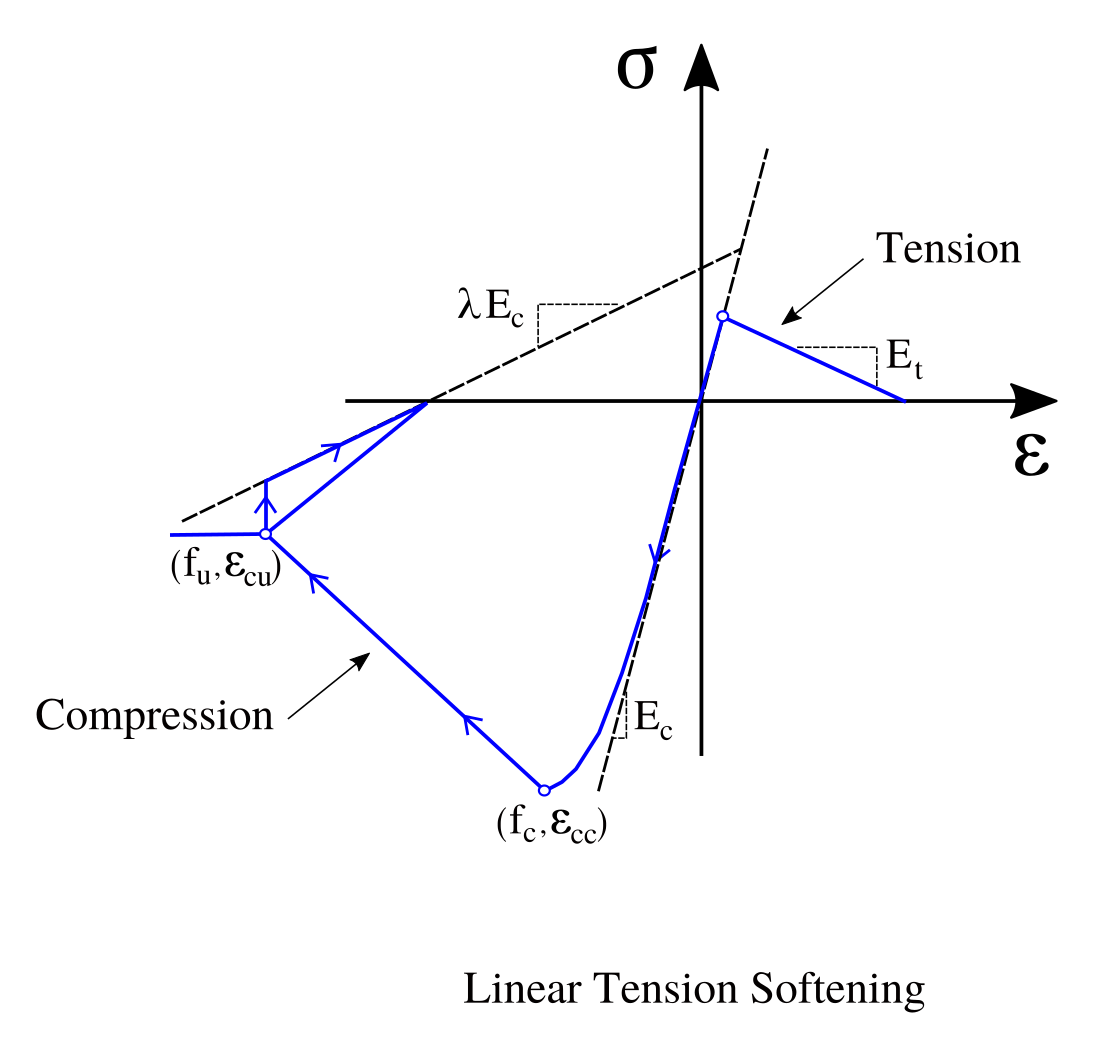The Concrete1DFiber class creates a uniaxial material with the constitutive equation given as
\[ \sigma = \begin{cases} E_t \, \epsilon \quad\quad & \text{, for } 0 \leq \epsilon \leq \epsilon_t, \\ f_c \frac{\epsilon}{\epsilon_{cc}}\left(2 - \frac{\epsilon}{\epsilon_{cc}} \right) & \text{, for } -\epsilon_{cc} \leq \epsilon \leq 0,\\ f_c \left( 1 - \frac{\epsilon - \epsilon_{cc}}{\epsilon_{cu} - \epsilon_{cc}} \right) & \text{, for } \epsilon \leq -\epsilon_{cc} \end{cases} \]
where \(\sigma\) is the uniaxial stress, \(\epsilon\) is the uniaxial strain, and \(f_c\) is the concrete compressive strength, \(\epsilon_{cc}\) is the concrete strain at maximum strength, and \(\epsilon_{cu}\) is the concrete strain at crushing strength. The Figure shows the constitutive law of this material. No hysteresis behavior is present for this formulation.

REFERENCE:
The python Pre-Analysis in the 01-Pre_Process/Method/Attach.py file provides with an interface to populate the Entities dictionary. This file contains several functions to populate specific fields. For example, to create a Concrete1DFiber material using json format, use:
addMaterial(tag, name='Concrete1DFiber', attributes):
Example
A CONCRETE1DFIBER can be defined using the python interface as follows:
SVL.addMaterial(tag=1, name='Concrete1DFiber', attributes={'fc': -5.73, 'ecc': -0.003, 'fcu': -1.146, 'ecu': -0.021, 'ratio': 0.05, 'ft': 0.28, 'Et': 430.0})
Application
Please refer to the A17-DY_1D_Material_Fiber_Concrete.py file located at 03-Validations/01-Debugging/ to see an example on how to define a PlasticPlaneStrainBA material.
On the contrary, the 01-Pre_Process/Method/Remove.py file provides with an interface to depopulate the Entities dictionary. For example, to remove an already define Material, use:
The C++ Run-Analysis in the 02-Run_Process/02-Materials/03-Fiber/Concrete1DFiber.cpp file provides the class implementation. A Concrete1DFiber is created using the built-in json parse-structure provided in the Driver.hpp. A Concrete1DFiber is defined inside the "Materials" json field indicating its "Tag" as follows,
{
"Materials": {
"Tag": {
"name" : "CONCRETE1DFIBER",
"attributes": {
"fc": double,
"ecc": double,
"fcu": double
"ecu": double,
"ratio": double,
"ft": double
"Et": double,
"nu": double,
"rho": double
}
}
}
}
| Variable | Description |
|---|---|
Tag | Unique material object identifier. |
fc | The concrete compressive strength at 28 days. |
ecc | The concrete strain at maximum strength. |
fcu | The concrete crushing strength. |
ecu | The concrete strain at crushing strength. |
ratio | Ratio between unloading slope at and initial slope. |
ft | The concrete tensile strength. |
Et | The tension softening stiffness (absolute value). |
nu | Represents the Poisson's ratio. |
rho | Represents the material density. |
A uniaxial CONCRETE1DFIBER with compressive strength 5.73, strain at maximum strength 0.003, concrete crushing strength 0.021, ratio 0.05, and tensile strength and softening stiffness of 0.28, 430 respectively:
{ "Materials": { "1": { "name" : "CONCRETE1DFIBER", "attributes": { "fc": -5.73, "ecc": -0.003, "fcu": -1.146, "ecu": -0.021, "ratio": 0.05, "ft": 0.28, "Et": 430.0, "nu" : 0.25, "rho": 0.0 } } } }